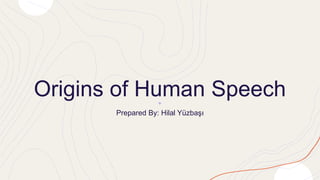
Origins of Human Speech
- 1. Origins of Human Speech Prepared By: Hilal Yüzbaşı
- 2. 1) The Divine Source It is believed that language is a gift of God to humans. That means humans have an innate capacity oto use language. But empirical evidence from children raised without wxposure to language shows that these children grow up with no language at all
- 3. 2) The Natural Source Theory 2.1) Bow-Wow Theory Human vocabulary developed from animal noises. For instance; meow, moo, quack, etc. Ontomatopoeia: The imitation of a sound in naming. - Limited part of vocabulary - Differ from language to language
- 4. 2) The Natural Source Theory 2.2) Pooh-Pooh Theory Humans' first words were derived from spontaneous expressions of dislike, hunger, pain, pleasure, etc. - Very small part of any language - Differ from language to language
- 5. 2) The Natural Source Theory 2.3) Ding-Dong Theory Humans named actions, objects and phenomena after a recognizable sound associated with it. For instance, ''boom'' which means explosion as in English, ''tun-tun'' which means heart as in Chinook Indian. -Limited part of vocabulary -Differ from language to language
- 6. The Biggest Problem of Thoese Theories: Where do names for natural noisless concepts come from? For instance; rock, sun, sky, love, hate, etc.
- 7. 2) The Natural Source Theory 2.4) Ta-Ta Theory Charles Darwin theorizde that maybe the first word were lip icons of hand gestures. -Same gestures' meaning differs from language to language -Even, Darwin, himself thought that this was a little implausible.
- 8. Note Necessity Hypotheses: Language evolved from the warning signals used by animals. Perhaps language started with a warning sound to others that stands for ''help'' or ''run'' to alert other members to a dangerous issue.
- 9. 3) Social Interaction Source Early people must have lived in groups to protect themselves from any attack. Thus, to retain in this group, they have to communicate. Then, sounds occured from some social interacions of early people. -Some mamals, primates, etc. Live in social groups like early people. They warn each other using some sounds yet this is not enough for speech ability.
- 10. 4) Physical Adaptation Source It is about the development of our posture and body. In early times, human learnt how to stand on two feet (bi-pedal position). It causes some changes in the way we breathe. Moreover, some changes occured in our up-right teeth, intricate lip muscles, smaller-thicker-more musclar tongue, and also the ability to close off the nose to create more air pressure for sound in mouth cavity. Thus, the human larynx (voice box), which contains the vocal cords, came in a lower position, creating a longer cavity called pharynx (big echo chamber above the vocal cords for volume and clarity of sound).
- 11. 4) Body Changes in Physical Adaptation Source 1) Posture 2) Teeth and Lips 3) Mouth and Tongue 4) Larynx and Pharynx
- 12. 5) Tool Making Source Early people created words from sounds like they made tools from objects. If they wanted to create a thing, for instance, first they found a rock and then another rock so they can put them together to make a tool. As in tool making, first they used sounds which stands for a meaning of a sense, an object etc. and then they put that sound together with another one. This sound combination became a sentence, phrase, situation for them
- 13. 6) Genetic Source Small phsical adaptations over time is not enough for explanation of language-born. Because even children who are borny deaf have the capacity of learning language. We can conduct that human children are born with a special capacity for language. That means language is an ability that is innate for human beings.